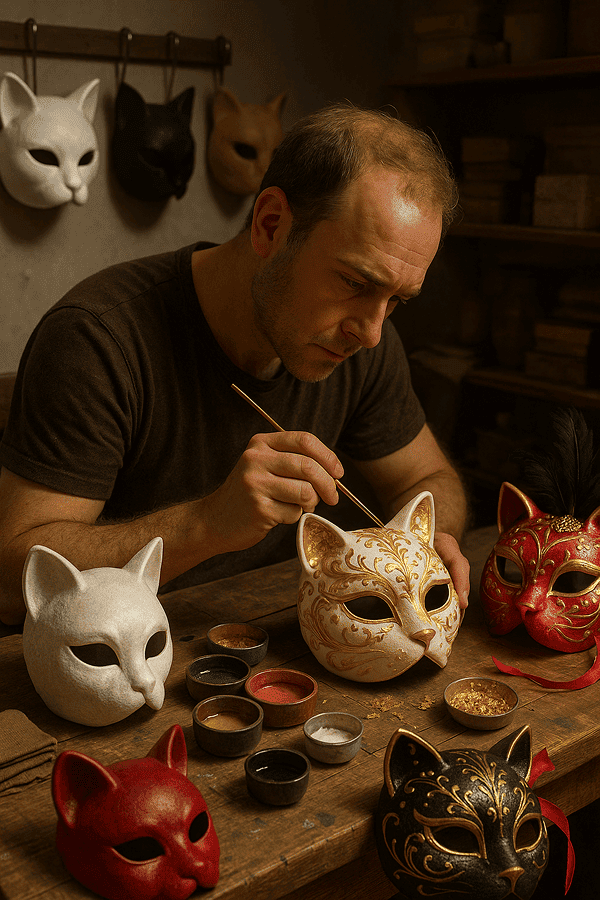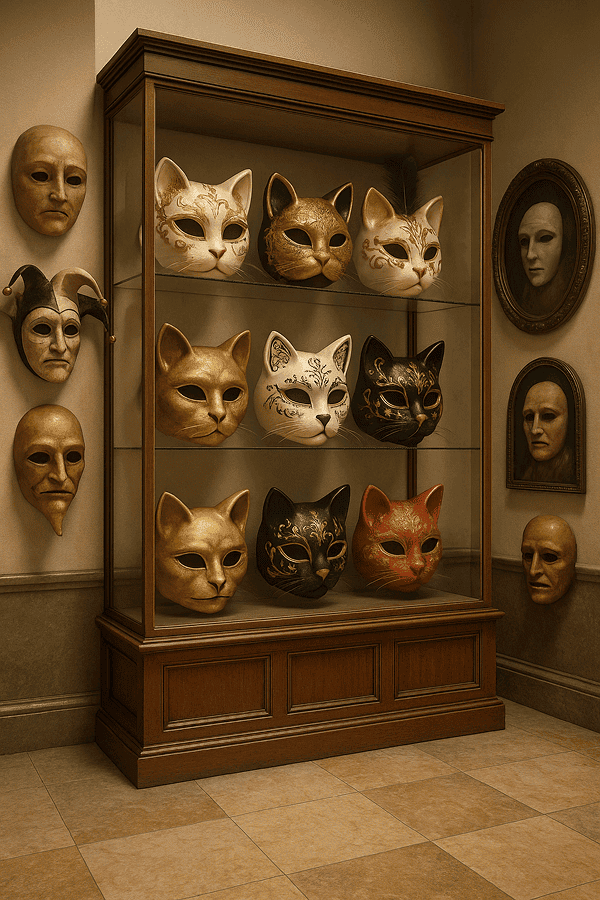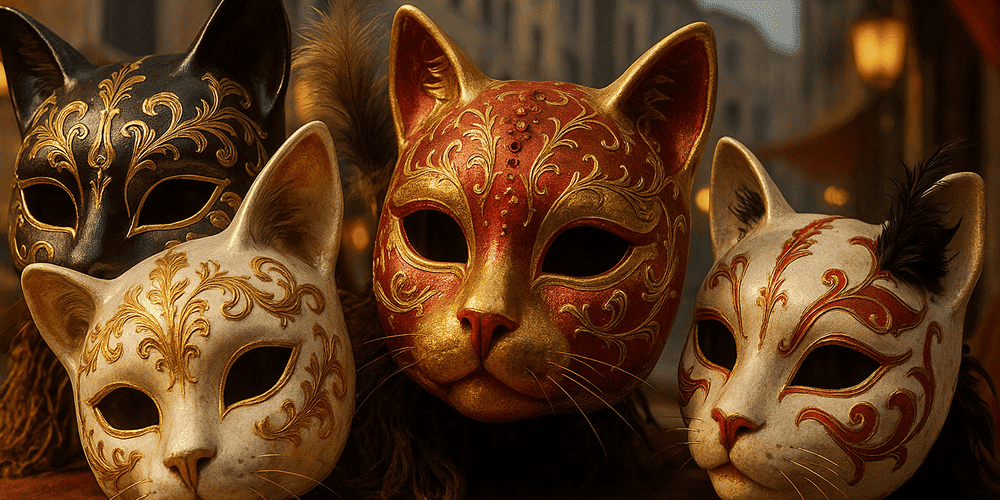The Gatto Mask, also known as the “Cat Mask,” is one of the most charming and instantly recognizable masks from Venetian Carnival tradition. Inspired by the feline form, the Gatto Mask features a rounded, slightly upturned nose, pointed ears, and gently slanted eyes that evoke the mysterious allure and playfulness of the cat. These masks are typically adorned with decorative patterns, gold or silver leaf, hand-painted details, and sometimes feathers, sequins, or gems. The Gatto Mask is closely linked to the culture and festivities of Venice, especially during Carnival, and has remained a popular choice for masquerade balls, street parades, and theatrical performances since its emergence in the 17th and 18th centuries.
Historical Origins of the Gatto Mask
The origins of the Gatto Mask are rooted in both Venetian folklore and practical necessity. The term “gatto” means “cat” in Italian, and in Venice, the cat has long been a symbol of agility, cunning, and independence. Some historians believe the Gatto Mask first appeared as a playful homage to the city’s much-loved cats, which were vital in controlling the rat population and preventing the spread of plague. Others suggest that the mask may have evolved from commedia dell’arte costumes, where animal characters — including cats — were common. Throughout the 18th century, Venetian mask makers began crafting feline-inspired masks, which quickly gained popularity among Carnival revelers for their comfort and ability to convey a sense of mystery. Over time, the design of the Gatto Mask has evolved, with artisans experimenting with proportions, embellishments, and color palettes. Today, the mask remains a beloved staple, often seen alongside other Venetian classics like the Harlequin Mask, each with its own unique flair.
Cultural Significance and Symbolism of the Gatto Mask
In Venetian culture, the Gatto Mask is rich in symbolism. The cat represents both freedom and secrecy — qualities prized during Carnival, when social boundaries were temporarily dissolved and anonymity reigned. The mask’s feline features evoke agility, curiosity, and a playful spirit, making it especially popular among those who wish to embody grace and cleverness. In some interpretations, the Gatto Mask is also linked to themes of transformation and duality, reflecting the cat’s reputation for having “many lives.” Stories and legends about cats as magical or protective creatures abound in Venetian folklore, making the Gatto Mask a talisman of luck and mystery. Socially, the mask allows wearers to interact with a sense of mischief, flirtatiousness, and theatricality — key elements of the Carnival experience. While the Gatto Mask lacks overt religious connotations, it is deeply embedded in the cultural and festive identity of Venice.
Materials and Craft Techniques of the Gatto Mask
Traditional Gatto Masks are crafted using papier-mâché, lightweight ceramics, or leather, ensuring they are comfortable for extended wear and suitable for elaborate decoration. The creation process begins with sculpting the feline form over a mold, followed by drying, sanding, and priming. Artisans then hand-paint the masks with intricate designs, applying layers of acrylic or tempera paint, and often embellish them with gold or silver leaf, glitter, and fine details. Decorative elements such as feathers, ribbons, sequins, and gems are added to enhance the mask’s visual appeal. Regional workshops across Venice have developed their own stylistic nuances, with some favoring minimalist elegance and others embracing lavish ornamentation. Color symbolism is also important — white for mystery, black for elegance, gold for luxury, and red for passion. The result is a mask that is both lightweight and striking, perfectly suited for the lively atmosphere of Venetian celebrations.

Functions and Uses of the Gatto Mask
The Gatto Mask serves a variety of functions, both ceremonial and theatrical. It is most famously worn during the Venetian Carnival, where it offers both anonymity and playful identity to its wearer. The mask is also used in masquerade balls, theatrical performances, and parades, allowing participants to embody the cat’s agility and charm. In modern times, the Gatto Mask has become popular at costume parties, cultural festivals, and art exhibitions around the world. While its primary function is festive, the mask also serves as a collectible art piece, admired for its craftsmanship and aesthetic appeal. Over the centuries, the use and meaning of the Gatto Mask have evolved, but its role as a symbol of Venetian artistry and celebration remains unchanged.
Regional Variations of the Gatto Mask
While the Gatto Mask is most strongly associated with Venice, its popularity has inspired variations in other Italian regions and even abroad. Venetian artisans are known for their elaborate decorations and use of high-quality materials, while masks from other cities may feature simpler designs or local motifs. Some workshops experiment with different feline breeds, incorporating features of wild cats or mythological creatures for a unique twist. Comparisons with other animal masks in European masquerade traditions reveal that the Gatto Mask is distinctive for its combination of elegance and playfulness, setting it apart from more somber or grotesque examples. Each region’s interpretation reflects its own artistic heritage, but the Venetian Gatto Mask remains the gold standard for craftsmanship and creativity.
Famous Examples and Collections of the Gatto Mask
Several renowned examples of the Gatto Mask can be found in Venice’s mask museums, such as the Museo Internazionale della Maschera Amleto e Donato Sartori and Palazzo Mocenigo. These institutions showcase historic and contemporary masks, including rare antique pieces from the 18th and 19th centuries and modern masterpieces by celebrated artisans. Collections often feature Gatto Masks alongside other Venetian classics, illustrating the evolution of mask-making and the enduring appeal of feline imagery. Private collectors and online galleries, including toddmasks.com, also play an important role in preserving and sharing exceptional Gatto Masks with global audiences. Occasionally, famous masks are displayed during special exhibitions or Carnival events, offering a glimpse into Venice’s rich masquerade tradition.

Influence of the Gatto Mask on Art and Culture
The Gatto Mask has left a significant mark on art, literature, fashion, and popular culture. Its graceful lines and mysterious aura have inspired painters, sculptors, and costume designers, while its playful symbolism appears in poems, novels, and theater. The mask’s image is frequently used in advertising, interior design, and even jewelry, reflecting its status as a symbol of Venetian luxury and intrigue. In cinema and opera, the Gatto Mask often signals mystery, seduction, or transformation, echoing its traditional role in Carnival. Contemporary designers sometimes reimagine the Gatto Mask in modern materials or minimalist forms, blending tradition with innovation. The mask’s enduring popularity ensures its place in the ongoing preservation and reinvention of Venetian cultural heritage. For those interested in the broader Carnival tradition, the Harlequin Mask offers another fascinating example of Venetian mask artistry.
Contemporary Status and Preservation of the Gatto Mask Tradition
Today, the Gatto Mask tradition is alive and thriving, sustained by master artisans, cultural organizations, and global enthusiasts. Venetian mask makers continue to produce both classic and innovative designs, often using traditional methods passed down through generations. The city’s workshops and ateliers are open to visitors, offering demonstrations, masterclasses, and opportunities to purchase authentic masks. Cultural festivals, school programs, and museum exhibitions help to educate new generations about the history and artistry of the Gatto Mask. Online resources — such as toddmasks.com — play a vital role in documenting and sharing mask-making techniques, ensuring the tradition’s survival in the digital age. Innovations in materials, design, and decoration continue to expand the expressive possibilities of the Gatto Mask, keeping it relevant for contemporary audiences.
Collecting and Acquiring the Gatto Mask
The market for Gatto Masks is robust, with authentic handmade examples available from Venetian workshops, artisan fairs, galleries, and reputable online shops. Prices vary widely, depending on the intricacy of design, materials used, and the reputation of the maker. Antique masks or those by renowned artisans can command high prices, while contemporary masks are more accessible. Collectors should seek out certified artisans, request certificates of authenticity, and support ethical, local sources. Toddmasks.com offers guidance on identifying genuine Venetian masks, understanding their artistic value, and making informed, respectful purchases. Ethical collecting not only supports artisans but also helps sustain Venice’s vibrant cultural heritage.
